
Nineteen Distinctive Places in Michigan listed in the National Register of Historic Places in 2023
Wednesday, February 7, 2024
Historic properties listed in 2023 help to tell a more complete history at the local, state, and national levels.
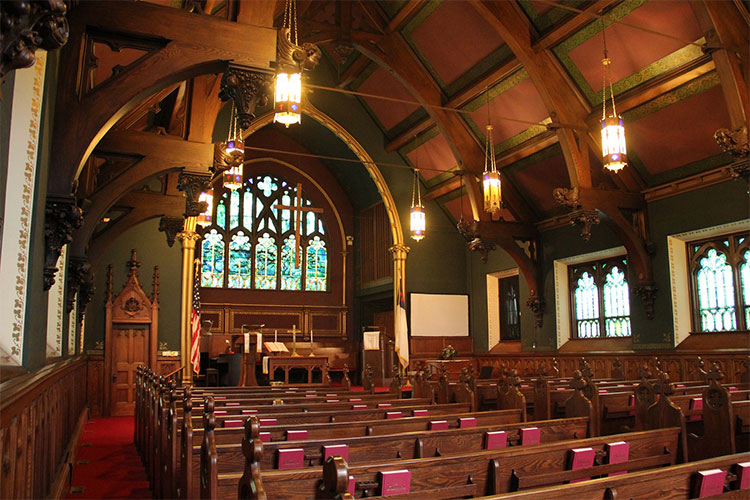
LANSING, Mich. – Nineteen historic Michigan properties were given special recognition in 2023 through their listing in the National Register of Historic Places, the Michigan Economic Development Corporation has announced. Administered in Michigan by the State Historic Preservation Office (SHPO), the National Register of Historic Places is the United States federal government's official list of districts, sites, buildings, structures, and objects deemed worthy of preservation for their historical significance.
“The SHPO has the distinct honor to be able to work with so many communities and individuals across the state to help elevate Michigan sites to the National Register of Historic Places,” said State Historic Preservation Officer Ryan Schumaker. “These 19 historic properties listed in 2023 help to tell a more complete history at the local, state, and national levels. Listing in the National Register not only provides a way to celebrate this important history, it also provides opportunities for economic investment in these properties and communities.”
More than 96,000 properties across the country, including nearly 2,000 in Michigan, have been listed in the National Register since the program began in the 1960s. The National Register is a program of the National Park Service and is administered by the states.
Each place listed in the National Register is referred to as a “property,” whether it is a single building, site, or structure or a historic district composed of hundreds of individual buildings. In 2023, fifteen individual properties and four historic districts totaling more than 146 contributing historic resources in Michigan were listed in the National Register.
To be considered for listing in the National Register, a property must generally be at least 50 years old, and must also be significant when evaluated in relationship to major historical events or trends in the history of their community, the state, or the nation. A property must also possess historic integrity – the ability to convey its significance.
The following Michigan properties were listed in the National Register in 2023:
|
Municipality |
Property Name |
County |
|
Alpena |
Herman and Hattie Besser House |
Alpena |
|
Benton Harbor |
Eden Springs Park |
Berrien |
|
Buchanan |
Clark Equipment Company Complex |
Berrien |
|
Detroit |
Frances Harper Inn |
Wayne |
|
Detroit |
Samuel D. Holcomb School |
Wayne |
|
Detroit |
Immaculata High School and Convent |
Wayne |
|
Detroit |
Pittsburgh Plate Glass Company Detroit Warehouse |
Wayne |
|
Detroit |
Saint Matthew Parish |
Wayne |
|
Detroit |
Vaughn's Book Store |
Wayne |
|
Grand Rapids |
Clipper Belt Lacer Company Complex |
Kent |
|
Grand Rapids |
Irving and Olive Crane Kendall Dean House |
Kent |
|
Grand Rapids |
Sligh Furniture Company Building |
Kent |
|
Grosse Pointe |
Cadieux School |
Wayne |
|
Grosse Pointe |
Grace Ingersoll McGraw House |
Wayne |
|
Lake and Holmes Townships |
Anaem Omot |
Menominee |
|
Lansing |
Barnes Avenue School |
Ingham |
|
Northfield Township |
Groves Farm |
Washtenaw |
|
Southfield |
John Grace School |
Oakland |
|
Wyandotte |
First Congregational Church |
Wayne |
"Each of these historic places is significant on its own, but what is all the more impressive is the story they tell together. Through these historic places – and so many others in our state – we can expand our understanding of where we call home as well as the stories, struggles, and accomplishments of those who came before us,” said SHPO National Register Coordinator Todd Walsh. “In the pages of each nomination, the people and places of our past come alive. I encourage everyone to learn more about their community, our state, and our shared history through the National Register program.”
To obtain copies of any of these National Register nominations or high-resolution photos, contact preservation@michigan.gov.
Listing of a property in the National Register is honorary and places no restrictions on what a property owner may do. They are not required to open the site to the public nor to display a plaque acknowledging the listing, although many companies offer plaques to recognize the hard work and effort to get a property officially listed. In addition, listing in the National Register provides opportunities for promotion, makes available certain incentives like grants and tax credits that foster investment in our cities, towns, and villages, and allows for the consideration of historic resources when federal funding or permits are involved.
Five Places of Learning become Places of Living in Metro Detroit, Lansing
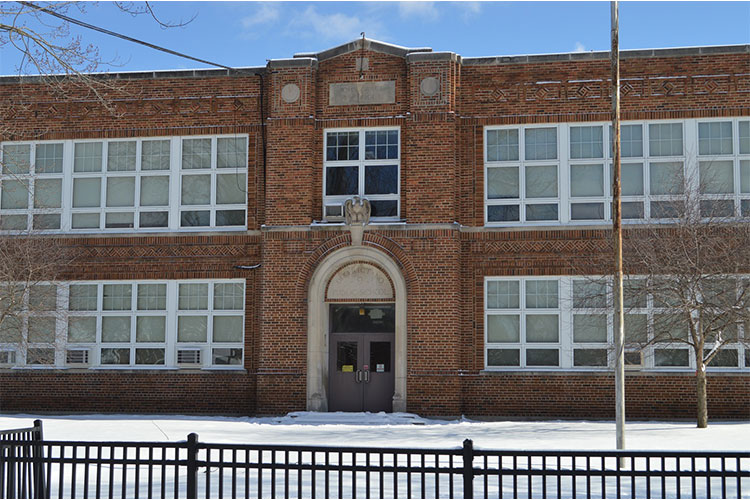
From urban neighborhoods to small towns, the local school was often a community anchor. As educational methods changed, schools changed and grew, too. But what happens to an old school when a newer facility is built elsewhere? Communities often struggle with how to best reuse these typically solid, well-constructed buildings. New neighborhood needs can often bring about a new use, such as conversion into apartments, senior housing, or a community center.
The adaptive reuse of school properties positively contributes to neighborhood character, well-being, and investment. Five former schools joined the National Register in Michigan in 2023, including properties in Detroit, Grosse Pointe, Lansing, and Southfield. National Register listing recognizes the buildings’ historic and often architectural significance to their local communities, and serves as a gateway for a redevelopment project to make use of historic preservation tax credits, an important financial incentive tool to help make adaptive reuse projects happen. Historic preservation tax credits allow a building to take on a new use while retaining the character-defining features that are memorable to generations of students.
Combining Recreation and Industry in Berrien County at Eden Springs Park in Benton Harbor, Historic District in Buchanan
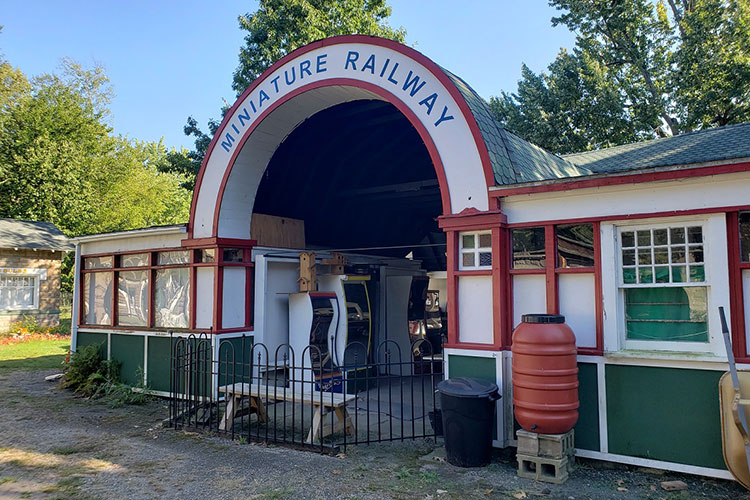
In southwest Michigan’s Berrien County, Eden Springs Park was once the ultimate recreation destination. Located in Benton Habor on the grounds of the House of David religious colony, the enterprising colony began charging an admission fee for the public to visit its gardens, and building recreational opportunities to expand this revenue source. For much of the 20th century the park offered amusements such as miniature train rides, musical and talent shows, a bowling alley, a penny arcade, a zoo with an aviary, home baseball and basketball teams, rental cabins, and extensive botanical gardens.
After closing permanently in 1973 and falling into extreme disrepair, a volunteer group has reopened the miniature railroad for train rides and begun to make other repairs to remaining buildings in the park. The group is working to restore some of the multi-sensory magic that visitors experienced on the site one hundred years ago.
“Eden Springs Park is an area with a unique history,” said Eden Springs Park Board Member Debbie Boyersmith. “The property itself has a rich history of Native Americans who knew the springwater was always flowing and healthy to drink. Most people now remember visits to the park for train rides, music, dancing, ice cream and other entertainment. The park changed and evolved over the years, and operated regularly until the early 1970’s. The park then sat dormant and became overgrown and deteriorated until 2009, when it was purchased, and is now in the process of being restored, including the vintage miniature steam-driven train rides. The park is run by volunteers, and visitors are encouraged to visit and learn more of its history. I hope being on the National Register will enable the preservationist group to obtain the means to continue and accelerate restoration.”
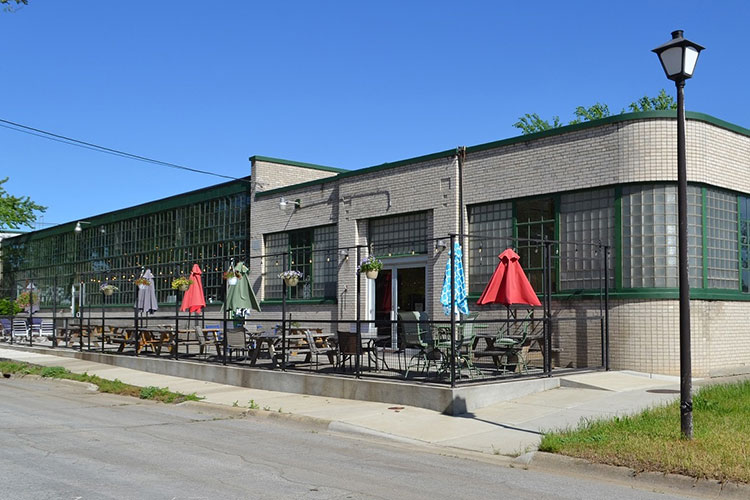
Across the county, for generations, the Clark Equipment Company put the small city of Buchanan on the map. From 1906 through the 1980s, the company produced axles, transmissions, and small industrial vehicles such as forklifts and Tructractors. After Clark vacated Buchanan, demolition and neglect followed. The 11-building historic district today points to the industrial history of the property while enabling new and creative uses, including an event space, small business/maker spaces, and municipal offices.
“Buchanan is very proud of its industrial legacy,” said city of Buchanan Community Development Director/Zoning Administrator Richard Murphy. “Clark Equipment played a pivotal role in Buchanan's rich history. Not only does this National Register designation tell the Buchanan story and bring notoriety and prestige to Buchanan, but it opens doors to significant historic tax credit funding that will assist in the continued redevelopment and reuse of the campus and buildings.”
Recognizing Michigan’s Artistic Excellence in Two Metro Detroit Churches
The National Register may recognize more than strictly history and architecture – properties significant as representatives of manmade expressions of culture or technology may also be listed. Distinctive finishes, materials, and works of art may give significance to a particular property. Although not typically eligible for the National Register, sacred places such as churches, synagogues, and mosques may be eligible for historic designation if they possess architecture or artworks that exhibit important stylistic trends or materials.
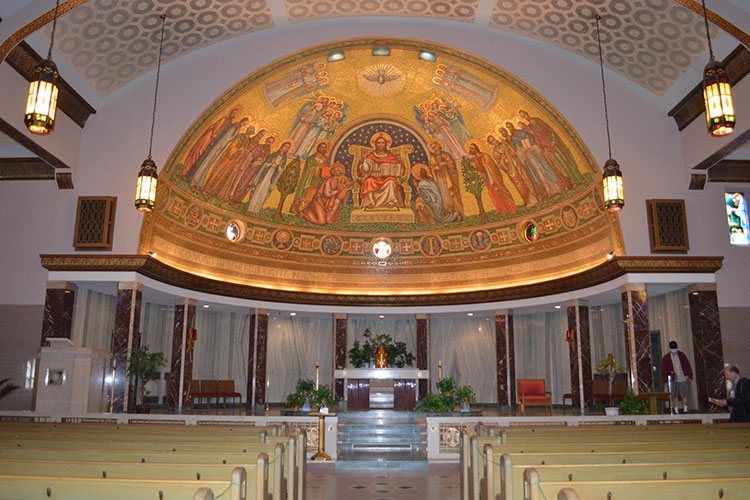
In metro Detroit, two churches were added to the register this year for their artistic significance. Detroit’s St. Matthew Parish, on the far east side, was completed in 1955 in a blend of traditional Romanesque Revival architecture with the Mid-Century Modern movement of the period, emphasizing both vertical and horizontal shapes. In contrast to these simple shapes on the exterior, the interior of the church was decorated by Sicilian-born Andrew R. Maglia. Although based in Detroit for much of his professional career, little is known about the complete scope of Maglia’s works. His work at St. Matthew included design and creation of the large stained glass windows, and the 1,300 square foot mosaic within the apse dome. Maglia was known for his experimentation with different mosaic materials, many of which have been lost through demolition elsewhere.
In Wyandotte, First Congregational Church also has historic significance in part due to its interior decorative treatment, which makes prominent use of richly carved wood and highly decorative stenciling treatments. The interior decoration of the 1903-built church was undertaken by the William Wright Company, the same company that stenciled and painted the nine acres of interior surfaces within Michigan’s State Capitol nearly twenty years before. Despite this and other prestigious commissions, no comprehensive catalog exists of the Wright Company’s designs. Research for the Wyandotte church included a study of sketchbooks held in the collection of the Michigan State Capitol. The First Congregational Church’s meticulous hand-painted and stenciled surfaces attest to the skill of the company’s talented craftsmen.

“As a historic designation program of the government, the National Register does not recognize any particular doctrine, but it does celebrate the significance of artists and designers whose work enhances sacred places,” said SHPO Project Coordinator Nathan Nietering. “Works of art are emblematic of American culture. You can’t help but look up and be impressed with these church interiors, which are a testament to their original designers, enduring for everyone to enjoy long after their creators have passed on.”
For more information about the National Register of Historic Places program in Michigan, and how to learn if your property might be eligible for listing in the National Register, visit https://www.michigan.gov/nrhp.
Focused on the historic preservation of culturally or archaeologically significant sites throughout the state, Michigan's State Historic Preservation Office strives to provide technical assistance to local communities and property owners in their efforts to identify, evaluate, designate, interpret and protect Michigan’s historic above- and below-ground resources. SHPO also administers an incentives program that includes state and federal tax credits and pass-through grants available to certified local governments.
About Michigan Economic Development Corporation (MEDC)
The Michigan Economic Development Corporation is the state’s marketing arm and lead advocate for business development, job awareness and community development with the focus on growing Michigan’s economy. For more information on the MEDC and our initiatives, visit www.MichiganBusiness.org. For Pure Michigan® tourism information, your trip begins at www.michigan.org. Join the conversation on: Facebook Instagram LinkedIn, and Twitter.
Recent Press Releases